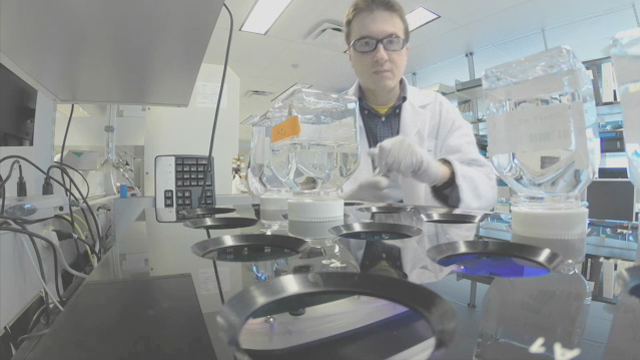CAMBRIDGE, Mass.--(BUSINESS WIRE)--Today Biogen Idec (NASDAQ: BIIB) announced that the U.S. Food and Drug Administration (FDA) has approved ELOCTATE™ [Antihemophilic Factor (Recombinant), Fc Fusion Protein] for the control and prevention of bleeding episodes, perioperative (surgical) management and routine prophylaxis in adults and children with hemophilia A. ELOCTATE is the first recombinant hemophilia A therapy with prolonged circulation in the body. It is the only treatment for hemophilia A to reduce the frequency of bleeding episodes with prophylactic infusions every three to five days, offering people with hemophilia A the potential to extend the interval between prophylactic infusions.
“The proven ability of ELOCTATE to provide protection from bleeding episodes with prolonged circulation marks the first significant hemophilia A treatment advance in more than 20 years,” said George A. Scangos, Ph.D., chief executive officer of Biogen Idec. “As a company deeply committed to improving the lives of people with hemophilia, we are excited to bring this important innovation to those living with hemophilia A.”
The recommended starting prophylactic regimen for ELOCTATE is 50 IU/kg every four days. Based on clinical response, the regimen may be adjusted in the range of 25 to 65 IU/kg and every three to five days.
In clinical trials, ELOCTATE was effective for both routine prophylaxis and to treat acute bleeding episodes with a favorable safety and tolerability profile. It was developed using a process called Fc fusion, which is designed to prolong the therapy’s circulation in the body using a natural pathway. The FDA’s approval is the first regulatory approval worldwide for ELOCTATE, and the therapy is currently under review by regulatory authorities in several other countries, including Canada, Australia and Japan. This FDA action follows regulatory approvals of Biogen Idec’s hemophilia B therapy, ALPROLIX™ [Coagulation Factor IX (Recombinant), Fc Fusion Protein], in the United States, Canada and Australia.
Hemophilia A is a rare, chronic, genetic disorder in which the ability of a person’s blood to clot is impaired. This can lead to recurrent and extended bleeding episodes. Complications of bleeding episodes may range from severe swelling and pain to arthritis, joint damage, physical disability and death.1,2,3 According to the National Hemophilia Foundation (NHF) guidelines, traditional hemophilia A prophylactic therapy involves infusions three times per week or every other day, which equates to approximately 150 to 180 infusions per year.
“Prophylactic treatment is recommended for people with severe hemophilia, and following a protective regimen can be burdensome given the frequency of infusions required,” said Patrick F. Fogarty, M.D.,4 assistant professor of medicine at the Hospital of the University of Pennsylvania, and director, Penn Comprehensive Hemophilia and Thrombosis Program. “Infusion frequency is a major challenge for people with hemophilia, and I believe ELOCTATE begins to address this burden while protecting against bleeding episodes.”
Therapies for hemophilia A, the most common form of hemophilia, can be administered either on a schedule to help prevent or reduce bleeding episodes (prophylaxis), or to control bleeding when it occurs (on-demand). The NHF recommends routine prophylaxis as optimal for the treatment of people with severe hemophilia. In recent years, regimens have shifted from on-demand treatment to routine prophylaxis because of observed improvement in long-term clinical outcomes, such as joint damage.
“We are encouraged by the arrival of new and innovative therapies, which may help address treatment gaps for the approximately 16,000 adults and children living with hemophilia A in the United States,” said Val Bias, chief executive officer of the NHF. “These advances, in conjunction with continued community education and empowerment, are critical to effectively serving the needs of people with the disorder.”
The approval of ELOCTATE is based on results from the global, Phase 3 A-LONG clinical study, as well as interim pharmacokinetic, or PK, and safety data from the Phase 3 Kids A-LONG study. PK is the measurement of the presence of the therapy in a person’s body over time.
The A-LONG study was an open-label, multi-center study that examined the efficacy, safety and PK of ELOCTATE in 165 previously treated males 12 years of age and older with severe hemophilia A. Results showed that adults and adolescents with severe hemophilia A achieved a statistically significant reduction of bleeding episodes in both of the study’s prophylaxis arms, relative to the on-demand treatment arm. In addition, 98 percent of bleeding episodes were controlled with one or two ELOCTATE infusions.
The study evaluated individualized and weekly prophylaxis to reduce or prevent bleeding episodes, and on-demand dosing to treat bleeding episodes. In the individualized arm, each study participant started on a twice-weekly dosing regimen. Participants’ PK parameters were used to guide adjustments to dosing interval (every three to five days), and dose (25 to 65 IU/kg) to target a minimum factor VIII level of 1 to 3 IU/dL or higher as needed to maintain control of breakthrough bleeding episodes. In the study, the dose in the weekly prophylaxis arm was 65 IU/ kg/week. The overall median annualized bleeding rates (ABR), or projected number of bleeding episodes per year, reported in the study were 1.6 for the individualized prophylaxis arm, 3.6 for the weekly prophylaxis arm and 33.6 for the on-demand arm.
No participants in the A-LONG study developed inhibitors to ELOCTATE. One participant had a transient, positive neutralizing antibody test result, which was not confirmed upon repeat testing. There were no reports of serious vascular (blood) clots or serious allergic reactions. Across the routine prophylaxis and on-demand therapy arms, adverse reactions were reported in 5.5 percent of participants. These adverse reactions included arthralgia (joint pain), malaise (general discomfort), upper abdominal pain, lower abdominal pain, angiopathy (vascular pain after injection of therapy), bradycardia (slow heart rate), chest pain, cough, dizziness, dysgeusia (taste alteration), feeling cold, feeling hot, headache, hypertension (high blood pressure), joint swelling, myalgia (muscle pain), procedural hypotension (low blood pressure) and rash. Each event occurred in two or fewer study participants. Two participants were withdrawn from the study due to adverse reactions: one participant due to rash and one due to arthralgia.
The pediatric indication for ELOCTATE is supported by interim safety and PK results in 38 boys ages two to 11 years old from the Phase 3 Kids A-LONG study. These data showed that ELOCTATE was generally well-tolerated and no inhibitors were detected. The relative increase in half-life (a measure of the time therapy remains in the body) seen with ELOCTATE was consistent with findings in adults and adolescents. In comparison with adolescents and adults, children two to five years old have a shorter half-life and higher clearance of hemophilic factors (adjusted for body weight); therefore, a higher dose or more frequent dosing may be needed in this age group. In April 2014, Biogen Idec and Swedish Orphan Biovitrum (Sobi) reported positive top-line results from the completed Kids A-LONG study, which confirmed and expanded upon the interim data.
Biogen Idec plans to make ELOCTATE commercially available to people with hemophilia A in the United States in July 2014. In the U.S., Biogen Idec will offer a variety of personalized assistance and resources through MyELOCTATE™ Services. As part of the company’s global commitment to the hemophilia community, Biogen Idec will provide equitable access to therapy including humanitarian donations. For more information on ELOCTATE, prescribing information and financial assistance programs, please visit www.ELOCTATE.com or www.biogenidec.com.
About ELOCTATE
ELOCTATE™ [Antihemophilic Factor (Recombinant), Fc Fusion Protein] is the first recombinant clotting factor VIII therapy with prolonged circulation in the body. It is indicated for the control and prevention of bleeding episodes, perioperative (surgical) management and routine prophylaxis in adults and children with hemophilia A. ELOCTATE is not indicated for the treatment of a bleeding disorder called von Willebrand disease. ELOCTATE was developed by fusing B-domain deleted factor VIII to the Fc portion of immunoglobulin G subclass 1, or IgG1 (a protein commonly found in the body). It is believed that this enables ELOCTATE to use a naturally occurring pathway to prolong the time the therapy remains in the body. While Fc fusion has been used for more than 15 years, Biogen Idec is the only company to apply it to the treatment of hemophilia.
Common adverse reactions (incidence of greater than or equal to 1 percent) reported in the A-LONG study were arthralgia (joint pain) and malaise (general discomfort). For complete prescribing information, go to www.ELOCTATE.com.
For members of the media interested in more information and additional resources, please visit www.biogenidec.com/us_media_corner.
About Hemophilia A
Hemophilia A occurs in about one in 5,000 male births annually, and more rarely in females, affecting about 16,000 people in the United States. The World Federation of Hemophilia global survey conducted in 2012 estimates that approximately 142,000 people worldwide are identified as living with hemophilia A.5 It is caused by having substantially reduced or no factor VIII activity, which is needed for normal blood clotting. People with hemophilia A experience bleeding episodes that may cause pain, irreversible joint damage and life-threatening hemorrhages. Prophylactic infusions of factor VIII temporarily replace clotting factor necessary to control bleeding and prevent new bleeding episodes.
About the Biogen Idec and Sobi Collaboration
Biogen Idec and Swedish Orphan Biovitrum (Sobi) are collaborators in the development and commercialization of ELOCTATE for hemophilia A and ALPROLIX for hemophilia B. Biogen Idec leads development, has manufacturing rights, and has commercialization rights in North America and all other regions in the world excluding the Sobi territory. Sobi has the right to opt in to assume final development and commercialization in Europe, Russia, the Middle East and Northern Africa.
About Biogen Idec
Through cutting-edge science and medicine, Biogen Idec discovers, develops and delivers to patients worldwide innovative therapies for the treatment of neurodegenerative diseases, hemophilia and autoimmune disorders. Founded in 1978, Biogen Idec is the world’s oldest independent biotechnology company. Patients worldwide benefit from its leading multiple sclerosis therapies. For product labeling, press releases and additional information about the company, please visit www.biogenidec.com.
Biogen Idec Safe Harbor
This press release contains forward-looking statements, including statements about the therapeutic impact of ELOCTATE and its potential impact on the treatment burden of patients with hemophilia A, and planned timing of commercial launch. These forward-looking statements may be accompanied by such words as “anticipate,” “believe,” “could,” “estimate,” “expect,” “forecast,” “intend,” “may,” “plan,” “potential,” “project,” “target,” “will” and other words and terms of similar meaning. You should not place undue reliance on these statements. These statements involve risks and uncertainties that could cause actual results to differ materially from those reflected in such statements, including uncertainty of success in our commercialization of ELOCTATE, which may be impacted by, among other things, slower than anticipated acceptance of ELOCTATE by patients and the medical community, intense competition in the hemophilia market, the effectiveness of our sales force and marketing efforts, problems with the manufacturing process for ELOCTATE, the occurrence of adverse safety events, difficulties in obtaining or changes in the availability of reimbursement for our products, failure to obtain regulatory approvals in other jurisdictions, including in the event other companies receive marketing approval of their treatments before approval of our treatments, failure to protect our intellectual property and other proprietary rights, product liability claims and the other risks and uncertainties that are described in the Risk Factors section of our most recent annual or quarterly report and in other reports we have filed with the U.S. Securities and Exchange Commission (SEC). Any forward-looking statements speak only as of the date of this press release and we assume no obligation to update any forward-looking statements, whether as a result of new information, future events or otherwise.
1 Nilsson IM, Berntorp E, Löfqvist T, Pettersson H. Twenty-five years’ experience of prophylactic treatment in severe haemophilia A and B. J Intern Med 1992;232:25-32.
2 Manco-Johnson MJ, Abshire TC, Shapiro AD, et al. Prophylaxis versus episodic treatment to prevent joint disease in boys with severe hemophilia. N Engl J Med 2007;357:535-44.
3 Panicker J, Warrier I, Thomas R, Lusher JM. The overall effectiveness of prophylaxis in severe haemophilia. Haemophilia 2003;9:272-8.
4 Editor’s Note: Dr. Fogarty has received researched support, and fees for consulting, from Biogen Idec.
5 World Federation of Hemophilia. Annual Global Survey 2012. http://www1.wfh.org/publications/files/pdf-1574.pdf. Accessed January 28, 2014.



![Image of Biogen Idec’s ELOCTATE™ [Antihemophilic Factor (Recombinant), Fc Fusion Protein], which was approved by the U.S. FDA on June 6, 2014 (Photo: Biogen Idec) Image of Biogen Idec’s ELOCTATE™ [Antihemophilic Factor (Recombinant), Fc Fusion Protein], which was approved by the U.S. FDA on June 6, 2014 (Photo: Biogen Idec)](https://mms.businesswire.com/media/20140606005891/en/419166/4/ELOCTATE_Product_Image.jpg)




![ELOCTATE™ [Antihemophilic Factor (Recombinant), Fc Fusion Protein] fact sheet ELOCTATE™ [Antihemophilic Factor (Recombinant), Fc Fusion Protein] fact sheet](https://mms.businesswire.com/media/20140606005891/en/419234/21/biogen-144.jpg)



